I always knew that I was going to love writing this Cult of the Lamb Review. Because as someone who is both a fan of indie games and weird, quirky experiences, I learned early on that keeping an eye on titles under the Devolver Digital umbrella was usually a really good habit for people like me. The company has achieved sort of a superstar status within the gaming community over the past couple of years, and that is in no small part due to the fantastic selection of unique games they have published, like Carrion, Loop Hero, and even the recently released Card Shark.
Of course, the fact that they also host the most insane press conference each summer in the form of the Devolver Direct doesn’t hurt either. But neither the conferences nor the company itself would have much appeal if the games themselves weren’t also great. And a couple of months ago at the 2022 Devolver Direct, we were shown an adorable new roguelike that instantly had me hooked.
It’s out now, and I have played it thoroughly from beginning to end. And I am here to tell you that this is one of the best games to come out this year, even if it does have a few issues that keep it from being a true masterpiece. So without further ado, let’s jump into this review.
- Developer: Massive Monster
- Publisher: Devolver Digital
- Release Date: August 11, 2022
- Platforms: Nintendo Switch, PlayStation, PC, Xbox
- Predecessor: None
Story And Setting
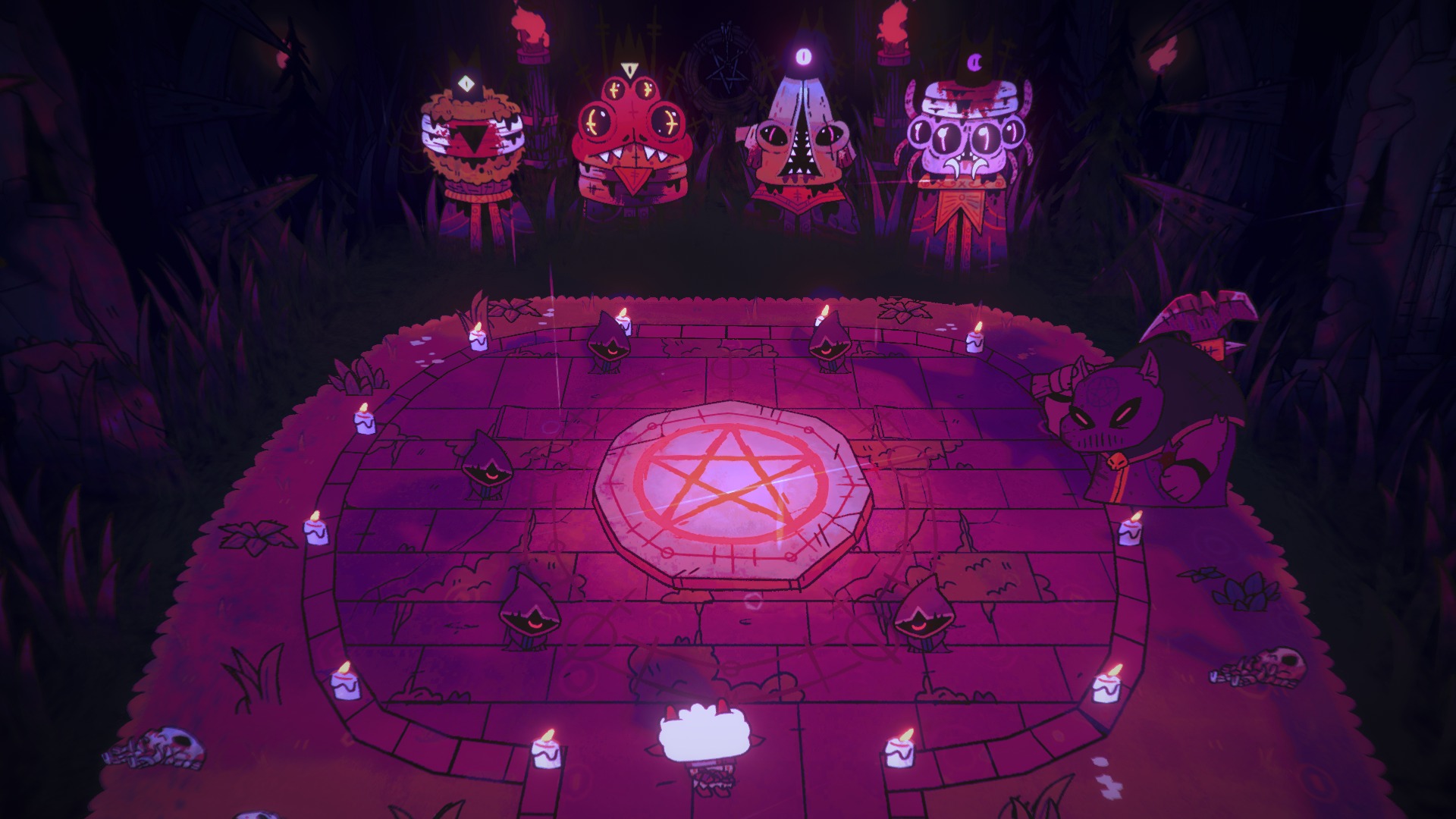
When the game first starts off, you are immediately put in the shoes of a cute little lamb that has been shackled and is being made to walk towards its execution. Your captors seem to belong to some sort of nefarious cult led by four towering beings known as ‘The Old Gods.’ They stand before you like some sort of jury, and mumble cryptically about having wiped out your race, and some prophecy that can no longer come to pass once you are also killed.
And no, you do not get to simply walk away from this situation through sheer luck or by the hand of some rescuer. You are actually executed and then wake up in a sort of afterlife, where another mysterious entity known as ‘The One Who Waits’ asks you to start a cult in their name and eventually free them. You obviously accept the proposition and are bought back to life, and to kickstart your journey you also relieve a magical crown straight from the being’s own head.
From here you get to exact sweet sweet revenge against your enemies, and basically, murder your way to freedom. A short tutorial section after this point gets you acquainted with the basics of combat, as well as some other primary mechanics that are essential to the experience. You also encounter an NPC named Ratau, a former cult leader that is your primary source of exposition throughout the game.
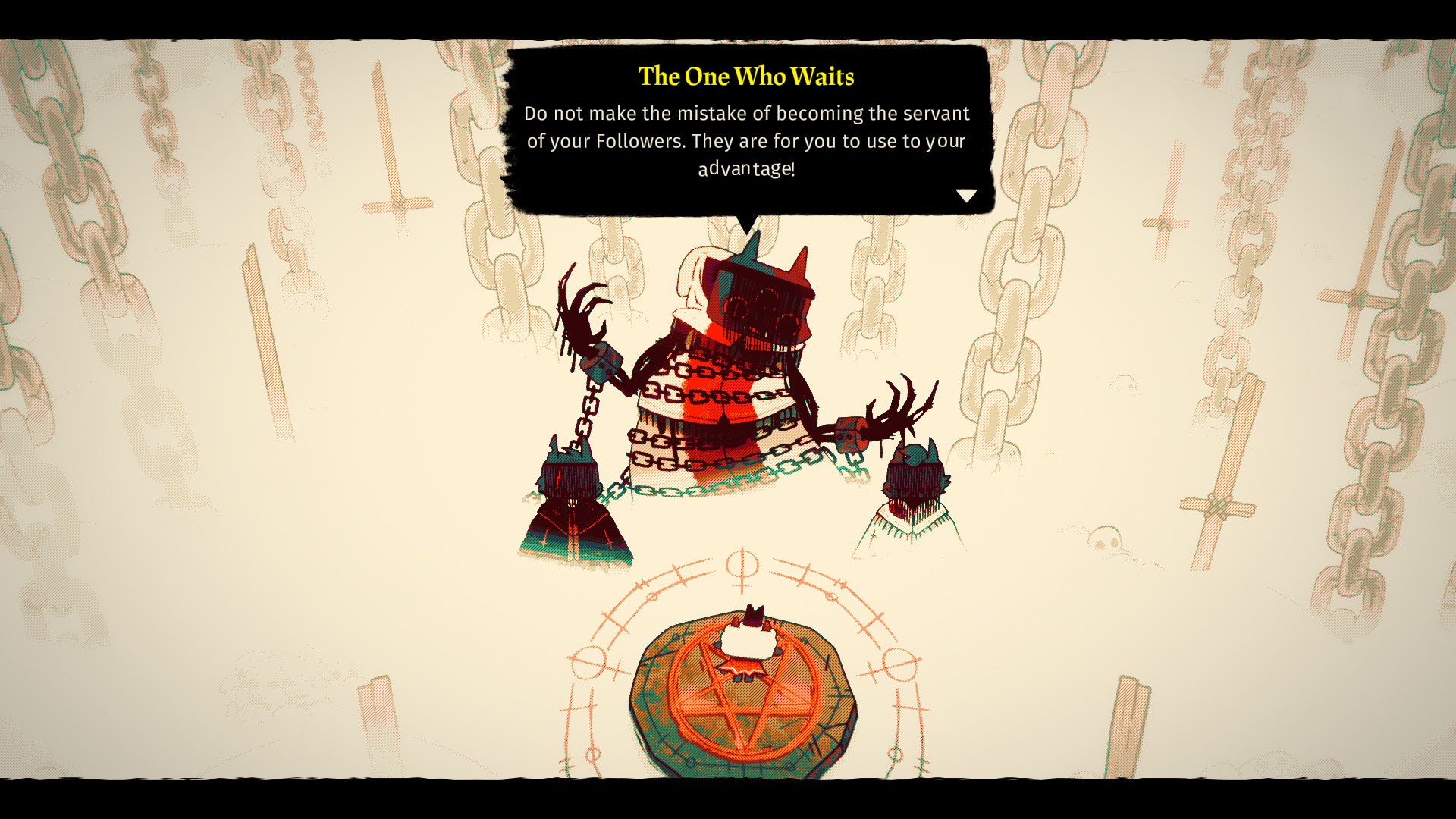
Now as far as initial setups go, this is all pretty awesome. The opening is delightfully creepy and adorable in equal measure, and it wastes almost no time in getting you acquainted with the primary villains of the story. You also get to meet your main ally, and you are given a reason for why you would want to actually join up with them. You were literally bought back to life by your savior, the least you can do is indoctrinate a bunch of other forest animals in their name. And that’s exactly what the point of the Cult of the Lamb is.
You divide your attention between managing your cult and exploring the world in order to kill all four of The Old Gods, and sprinkled in between this gameplay loop is the basis for some really good worldbuilding and random bits of lore. I’m not going to pretend that the overall story is fantastic, because that’s not the type of thing the developers were going for here.
This is a roguelike, and you randomly meet different side characters while exploring that you can talk to or do quests for, who in turn give you more information about the world.
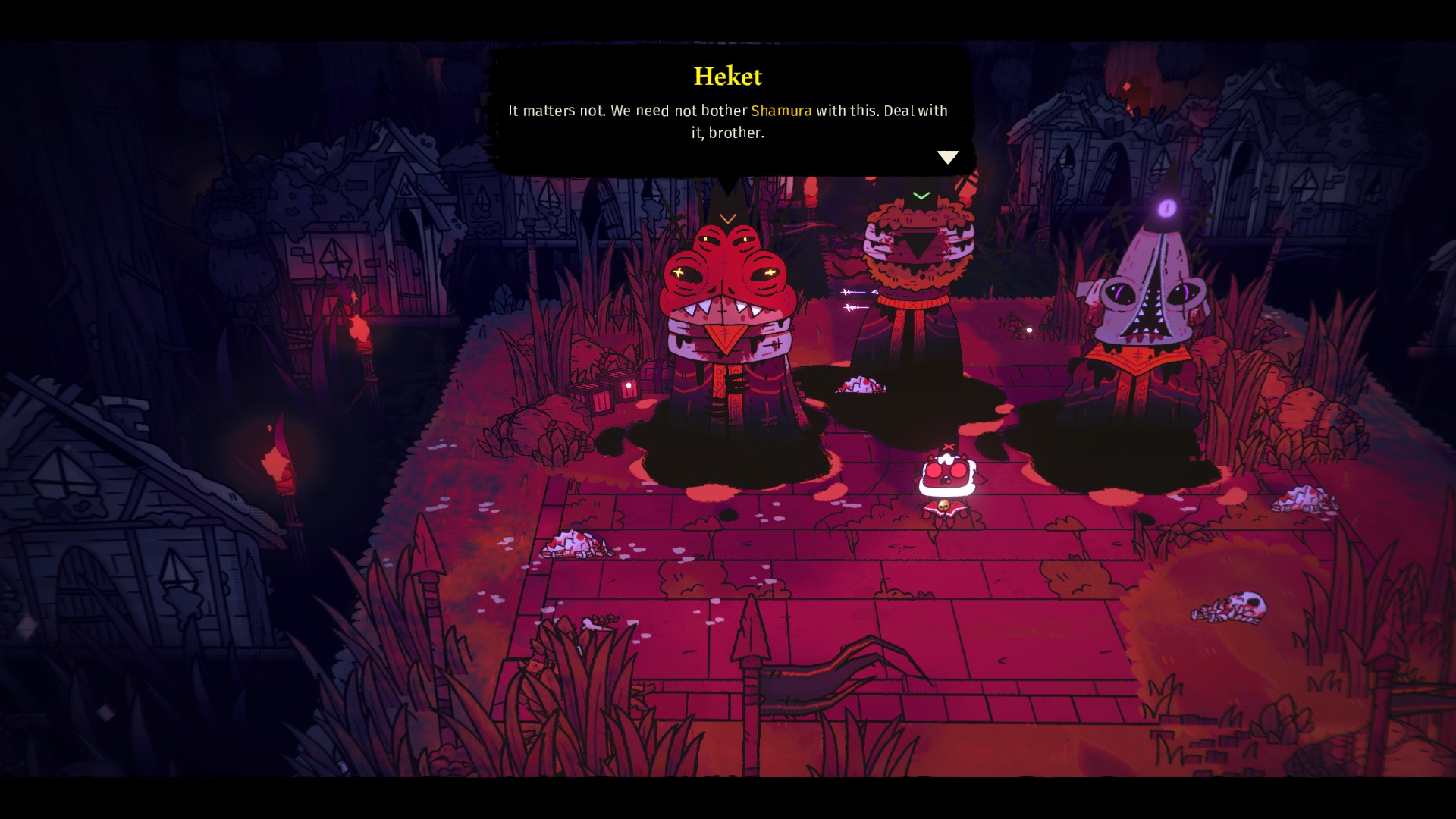
The writing is often decent, and many of the NPCs you’ll encounter are genuinely likable and creepy in equal measure. You also get the feeling that you don’t have the full story yet, and that maybe there’s more to the entire situation. And as you play through the story, more and more is eventually revealed to you.
And all of this exploring, killing, cult management, etc. takes place in an incredibly cutesy setting that I can only describe as a world populated by murderous plush animals. Cult of the Lamb would have been a decent game even without this stylistic choice, but in the end, the morbid and downright hilarious presentation is what truly sets it apart. If you have watched any of the trailers released so far, then you know exactly what I’m talking about.
Gameplay

As mentioned earlier, the core gameplay of Cult of the Lamb revolves around two distinct parts; the roguelike combat and the actual cult management. Now some of you may assume that the game focuses on both of these aspects equally, but that’s not quite true either. Both of these halves support each other of course, because you literally cannot progress through the campaign without either of them, but in the end, the management aspect is where you’ll spend most of your time.
Speaking of which, let’s actually start talking about your cult. After the opening moments where you escape from The Old Gods, you’re given access to a small patch of land where you can establish your commune. Your goal is to create a sustainable community, complete with all of the essentials that would be required for such a place. And the first thing you require is manpower, or cultists in this case.
While exploring each of the dungeons in the game, you will often come across other animals that are either held captive by the followers of The Old Gods, or maybe require some other type of assistance. You can help them, and they can then be teleported back to your base. From there, you can formally indoctrinate them into your cult, and assign them a task that they will focus on while you are out exploring and fighting.
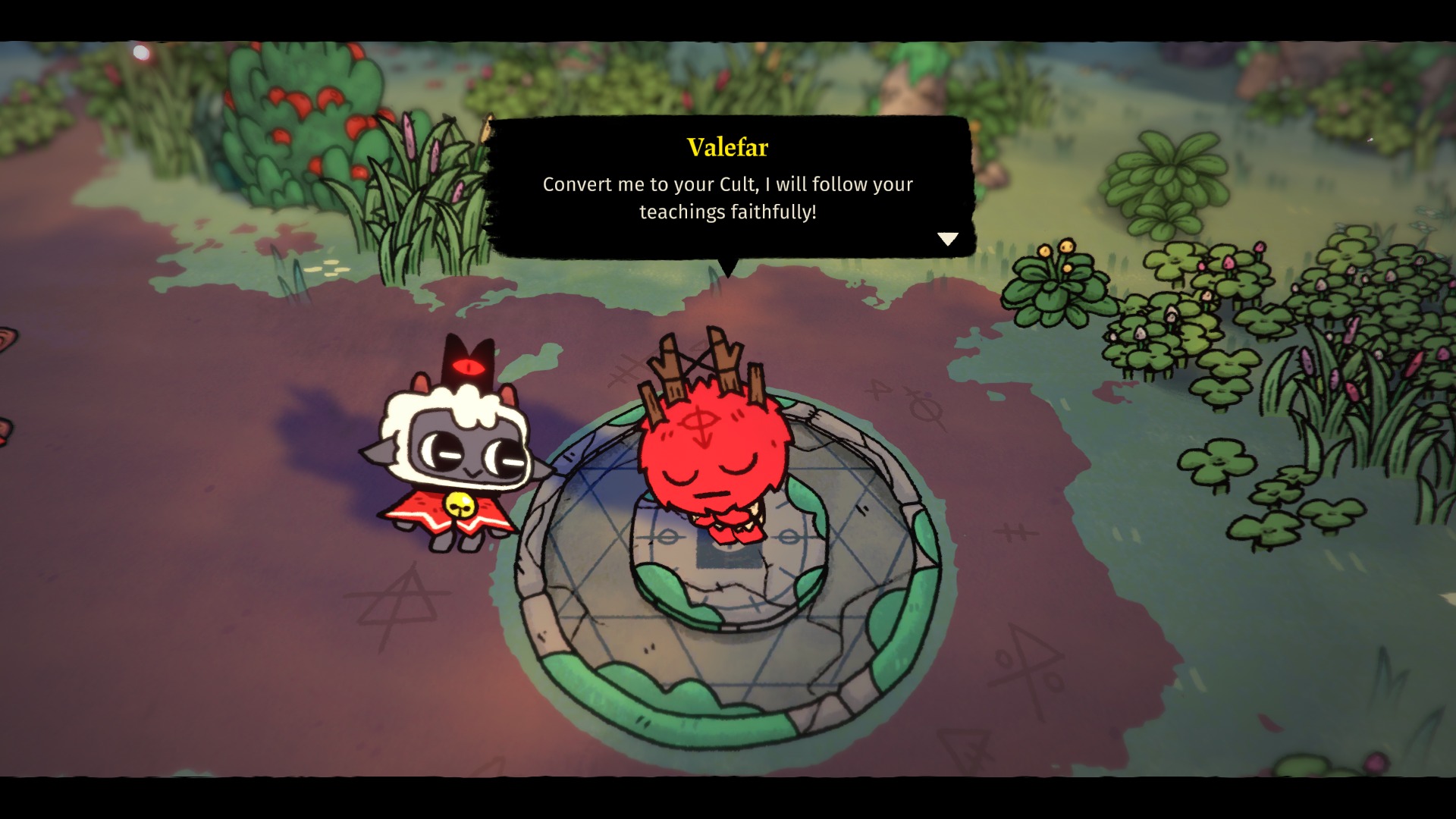
And like any living creature, they also have some requirements that you have to be keenly aware of at all times. They need places to sleep, a steady supply of food so that they do not starve, and even places to poop. You can also choose to talk to them, and help them carry out pranks or complete other side objectives to increase their loyalty. And not meeting these requirements can result in your followers becoming Dissenters, which will not only eventually cause them to leave the cult, but also persuade others to do the same. So you have to deal with problems like this promptly, and make sure that everyone is happy and taken care of.
As a standard, you also require your followers to mine rocks and chop down wood since those are the basics with which you can construct most other structures in the game. There are plenty of large boulders and trees around your commune to start with, and you have to use them to get a Cooking Fire running as well as lay down rudimentary Sleeping Bags for everyone. You can also start growing your own crops with Farm Plots and the Farmer Station, which can quickly help you secure a reliable food source. You also want to get your cultists praying at the Shrine as soon as possible, since this is how you generate Devotion.
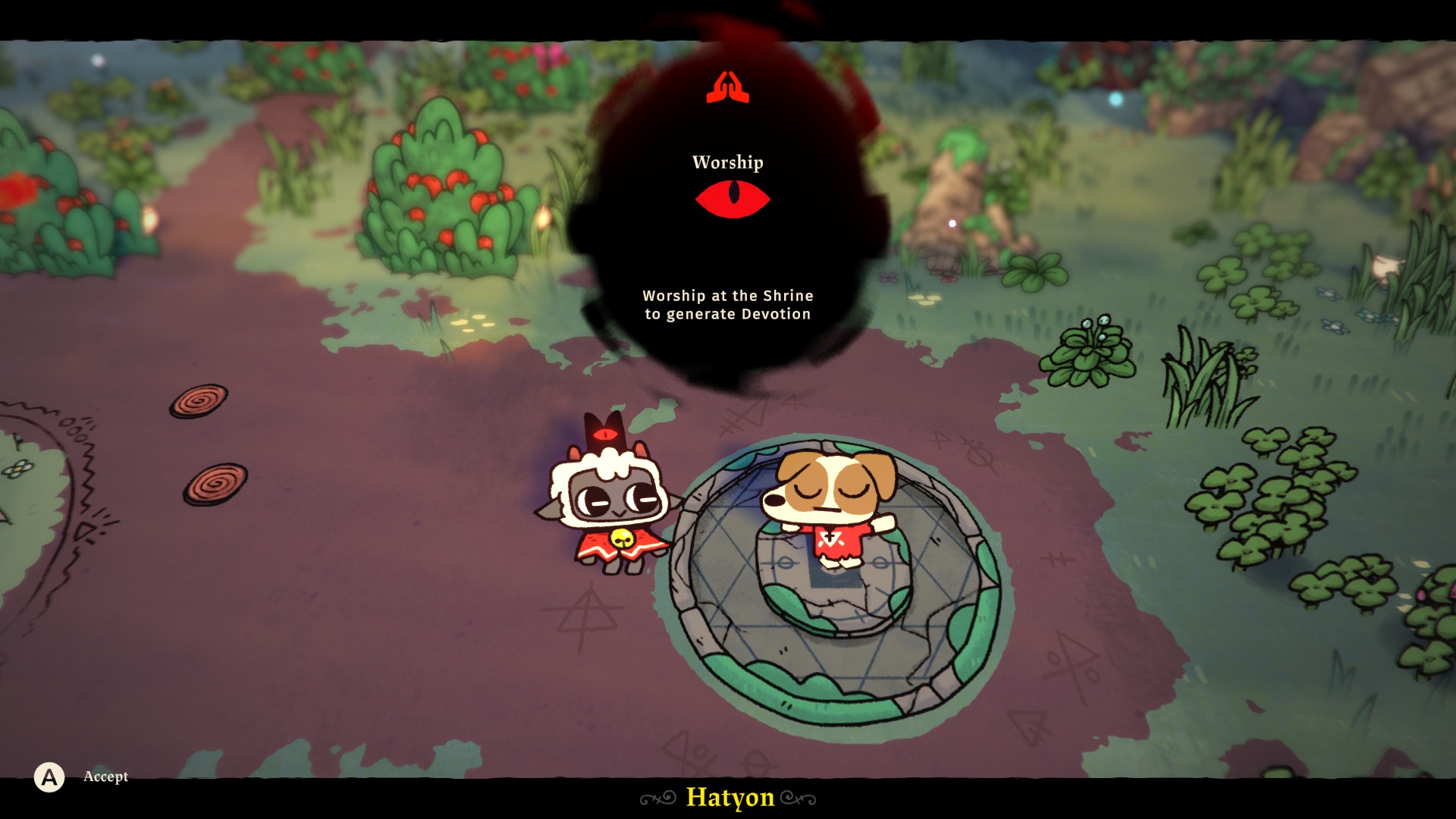
The way Devotion works is that you assign followers to spend time praying at the Shrine, and over time they deposit the resource into the structure. Players can go ahead and collect it whenever they want, and when a certain amount of it is in their possession, a Divine Inspiration is unlocked. This is basically like a skill point that allows you to unlock new buildings at the Shrine, which in turn will let you grow your cult and become self-sustaining. As you progress through the game, more options for resource generating, automation, and basic utilities like Outhouses can also be unlocked over time.
Perhaps the most important building in your entire camp is the Temple. Once you build it as part of the tutorial, you are able to use it not only to shape the belief system of your cult, but also to improve your dungeon runs going forward. The way this works is that you can use the Temple to conduct a Sermon once a day, which in turn rewards you with another important resource known as Faith. This can then be used in another tech tree to increase the capabilities of the weapons and abilities you find during the combat section of the game.
The more you care for your followers, the more loyal they are and the more Faith they will generate during a Sermon. They also have their own personal Faith meters, which can be increased or maintained by interacting with them, blessing them daily, and generally making sure you take care of them. As you progress through the game, you can even unlock Doctrines, which will in turn allow you to modify your cult’s behavior. Using these, you can make it so that everyone works faster, or that they generate Devotion at a much higher rate. You can even make it so that sacrificing one follower will in fact increase the Faith of others.
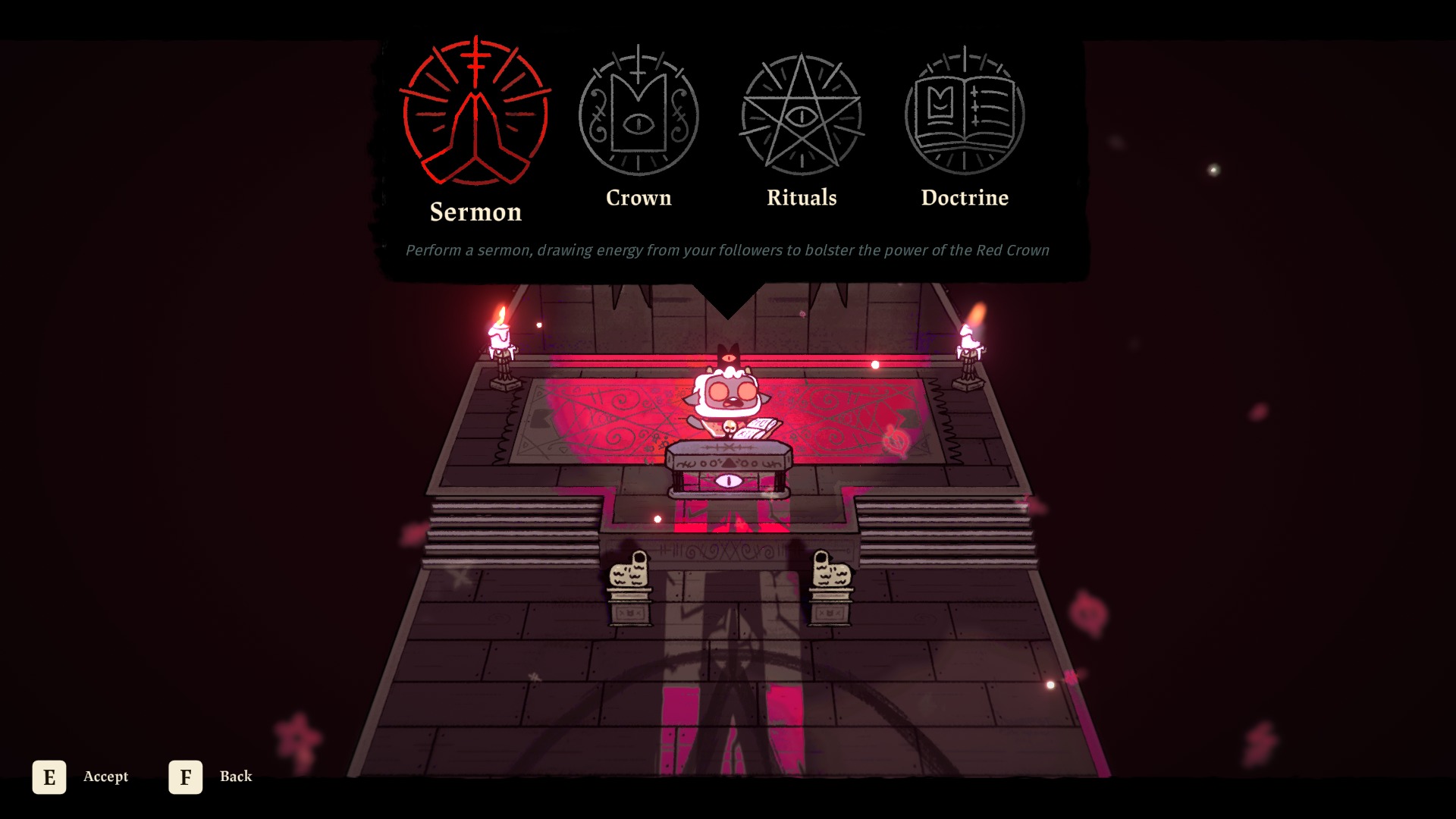
I know this is all getting a bit too convoluted, but there’s one final thing you can also do at the Temple. Over time while playing the game, you will also unlock a selection of rituals that can help both you and your cult get stronger. These range from simple things like Bonfire Rituals for improving the faith of everyone involved, or a Ritual Fast that will make it so no one will require food for 3 whole days. You can even choose to bring back someone who has died, including those followers that you can kill yourself as part of a sacrifice to get stronger.
Now as far as the combat itself is concerned Cult of the Lamb features a simple but satisfying gameplay loop that involves around exploring four distinct dungeons. You go through each of three these a total of three times each, and on the fourth time, you unlock a massive boss battle against one of The Old Gods themselves. But this of course is predicated on the fact that you manage to get through these runs without dying.
If you’ve played a lot of roguelikes, or even if you picked up 2020’s critically acclaimed Hades, then you have a general idea of how runs, or Crusades as they are known here. When you begin a run, you are usually given access to a random weapon and a Curse power, and that’s kind of the limit of what you have.
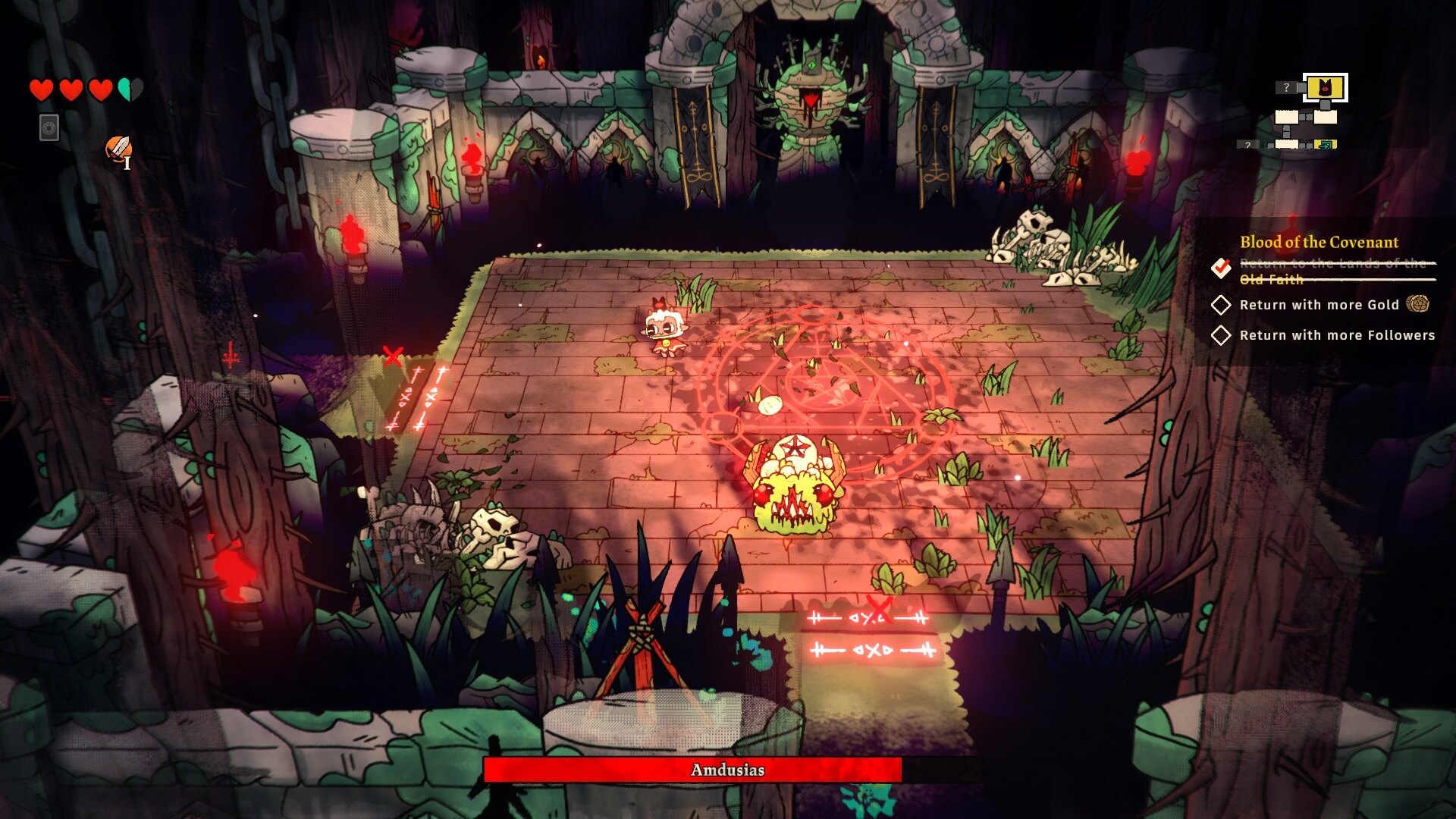
You attack with your weapon with one button, launch a spell with another, and finally, you have a dodge button that lets you dive away from danger by making you briefly invulnerable. It’s nothing too fancy, and in fact, I’m fairly certain that this would have quickly gotten repetitive if not for the fact that the dungeons are short and the average run time is around 6 to 7 minutes.
Your weapon selection ranges all the way from fast swinging daggers and swords, all the way to heavier axes, hammers, and even claws. But not all of these are made equal. Combat in this game is really fast, and it sucks to say that apart from the blade weapon types, the hammer and claws simply do not feel all that useful. Hammers swing way too slow for their own good and constantly leave you open to attacks. And claws simply are not great at dealing damage unless you can really slow down and take the time to land a full combo on a foe. And since everything moves so quickly, with multiple different projectiles on screen at any one time, you can see how this could be annoying.
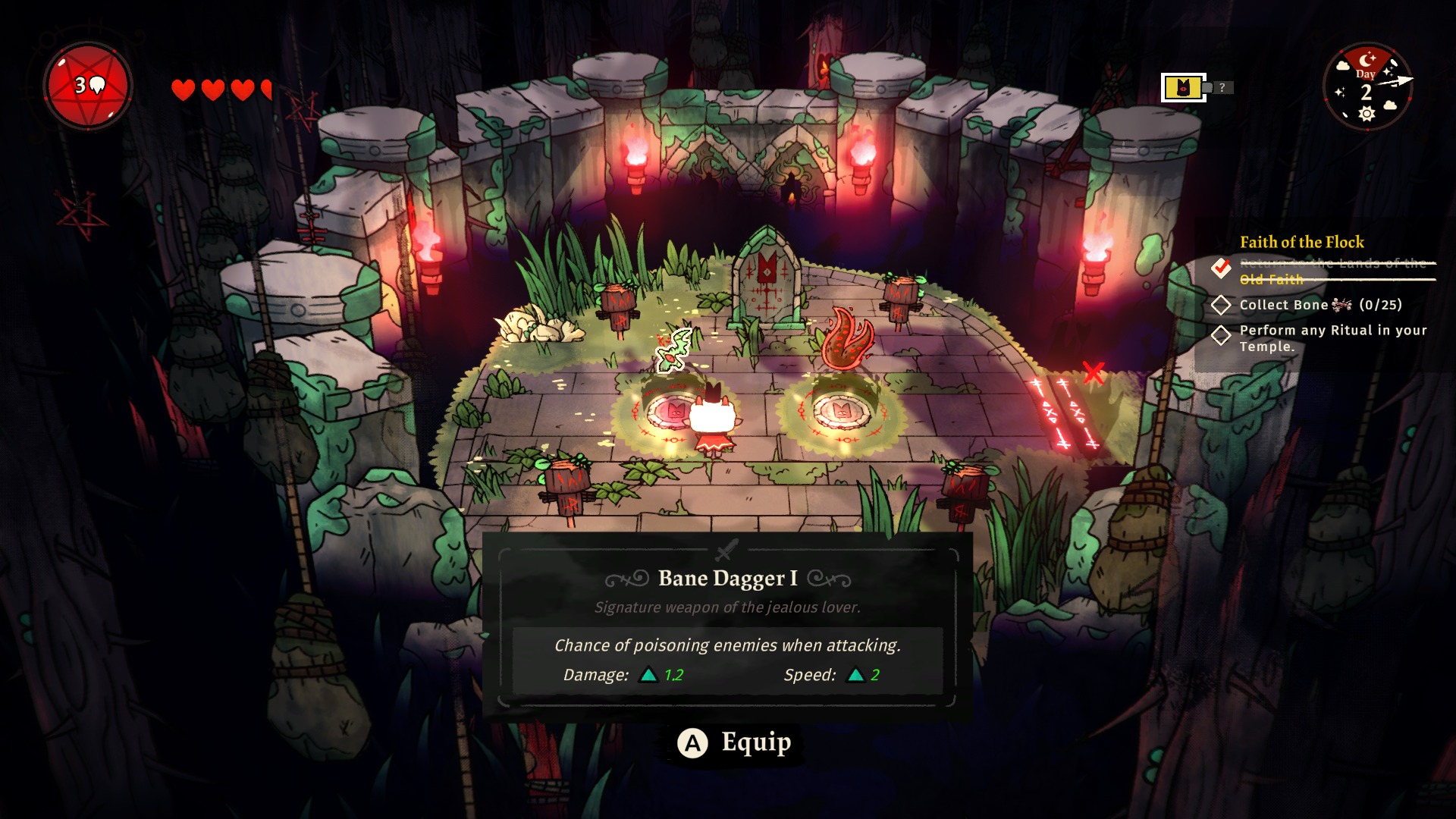
As far as Curse powers go, you have access to a wide variety of magic and melee abilities. Some of these simply allow you to launch a fireball at your targets, while others can create an area of effect attack that can knock back enemies all around you. You can create a black puddle of goo on the floor that can poison anyone who walks through it or even let out a devastating melee attack that can be charged for greater effect. They’re all really versatile, and you get a few opportunities during a run to switch them out if you feel like it.
While each Dungeon has a general theme and ambiance, the routes within them are usually procedurally generated. You get to explore a number of rooms within each of these routes, and then at the end, you are given an option to choose where you would like to go next. Depending on your choices, you can either encounter a new follower, new equipment, or even general resources like food and wood.
Some of the rooms you explore during a Crusade can also be occupied by an NPC named Clauneck. He gives you a choice between two different Tarot cards, which act as buffs. These can provide everything from simple increases to your damage and attack speed, all the way to more health and even effects like poison weapons. Again, these are only temporary, and they go away as soon as your run does.
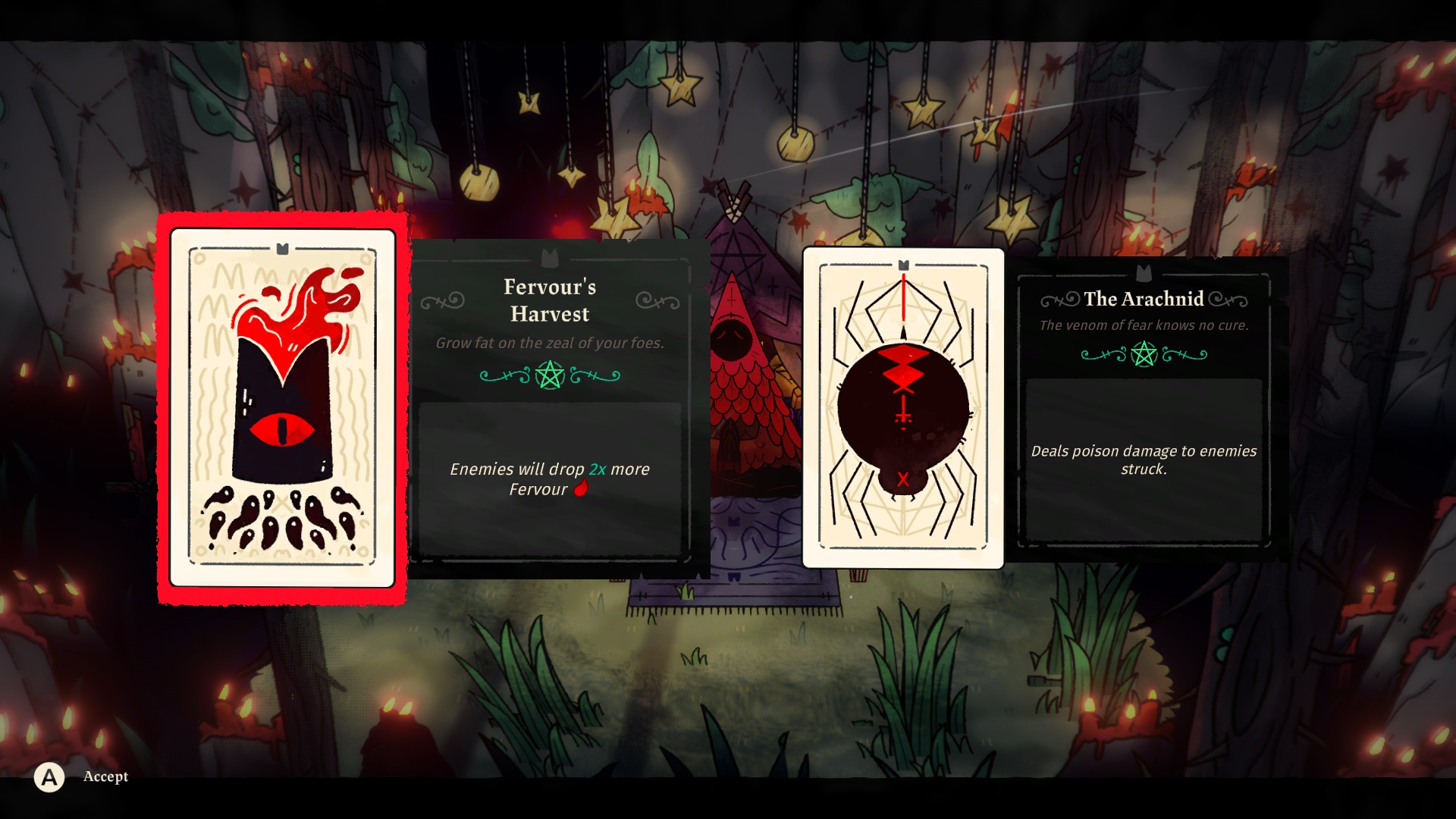
Another thing that’s worth mentioning is that Cult of the Lamb offers players a staggering amount of choice when it comes to customization. You are able to fully change the appearance of every single one of your followers, all the way down to the color of their skin and what kind of animal they are. There are even unique variations for each animal that help you distinguish one from another.
And this level of customization also extends to the base itself. You acquire blueprints for multiple different structures each and every single time you go out on a run, and these can then be used to truly customize your commune. It’s kind of annoying how often you get these because it actually locks you in a short animation where the acquire page is slotted into a book. This is not a major issue, I simply think it’s irritating.
Visuals And Performance

Even before you learn anything about the actual game, what catches the eye first of all is the incredibly charming premise. This is a morbid game that deals with a lot of gruesome stuff, but it’s all wrapped up in this layer of cute and cuddly humor that is reminiscent of adult-oriented cartoons like Happy Tree Friends. You’re killing gods, cleaning up poop, and sacrificing elders to an eldrich being, but you’re doing it all as a fluffy little lamb with a smile on its face.
And to back this all up and make it look even more cartoonish (not in a bad way), the game uses a beautiful art style that makes buildings, characters, and other environmental props look like cutouts against a 2D background.
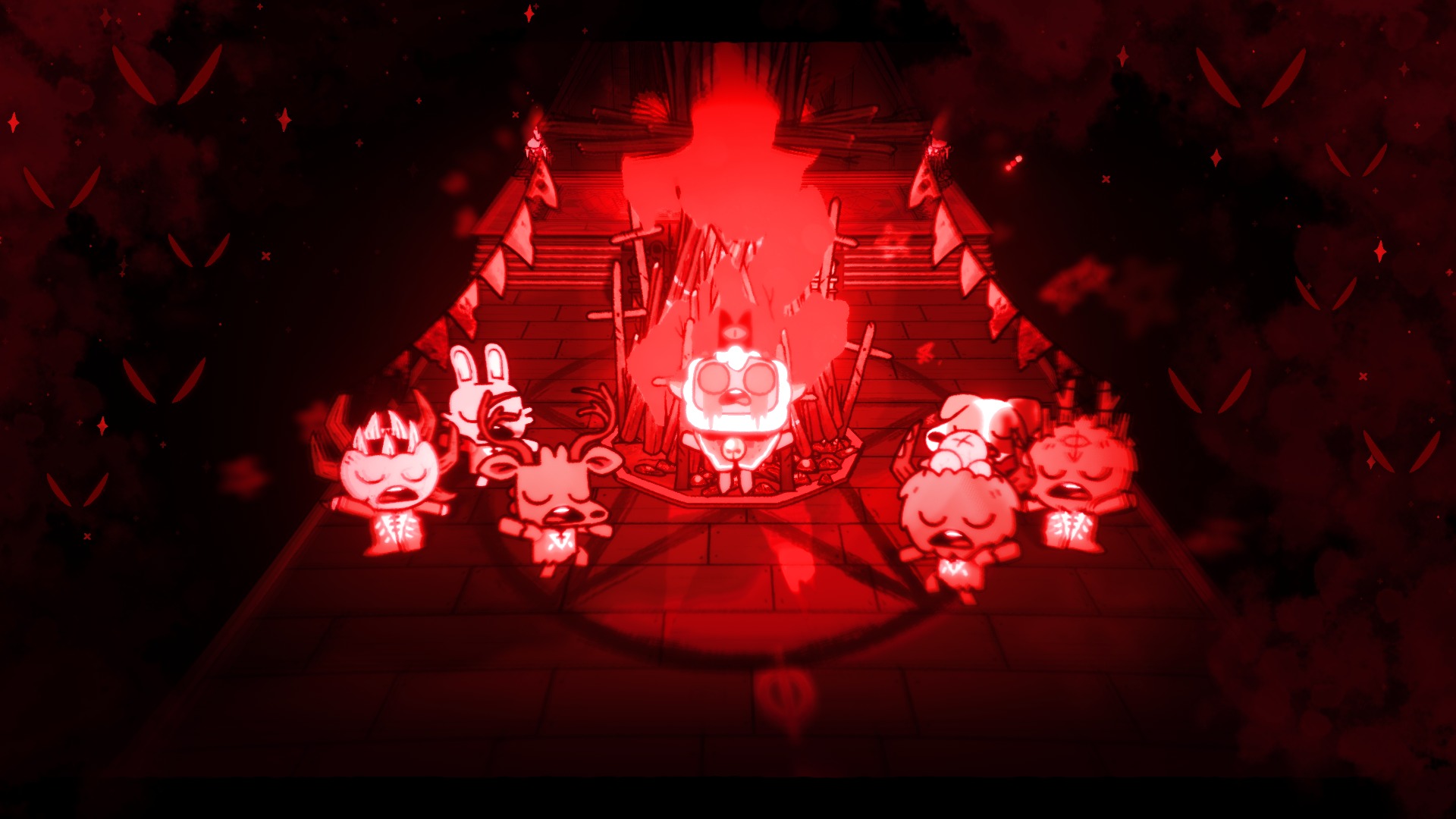
Every single frame of this game looks like a page from one of the most detailed art book I have ever seen, and there’s so much style and personality woven into each area of the world. I mean, just look at some of the images we’ve used in this article.
The game also runs really really well on even older GPUs. I broke out my old AMD RX 580 (4 GB) a few months back to test some games out, and I’ve since been using it as a benchmark for a lot of new indie games. I could easily run C ult of the Lamb at 1080p and 60 FPS without any major hitches. There were a few moments where the game stuttered for only half a second or so during some of the more hectic battles, but nothing so noticeable that it broke the flow of combat.
Cult of the Lamb Verdict
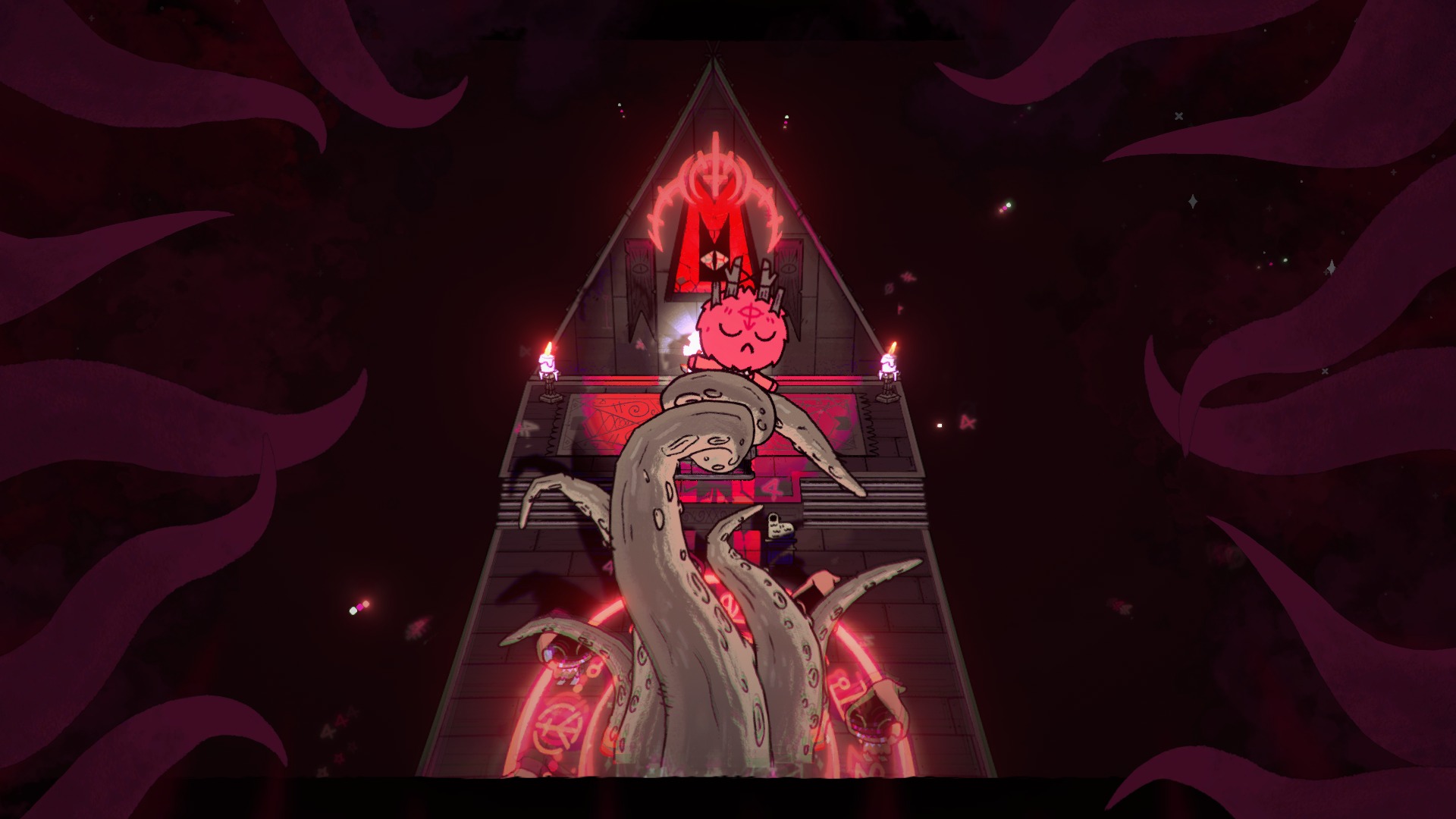
Cult of the Lamb is a fantastic new indie title from Devolver Digital that revels in the absurd nature of its setting. The art style is amazing, and generally, everything about the premise and atmosphere is phenomenal. From the way the cute and fuzzy cultists look and behave, all the way to the appearances of The Old Gods, this game is absolutely oozing with style. The 2D cutout look of almost every model is also a real standout.
The two halves of the gameplay loop are also really great. The management side is fun and engaging, and there’s you feel a real sense of accomplishment as you eventually grow your cult and automate processes like resource generation. Each upgrade tree is also cleverly attached to one of either Devotion and Faith, and investing time and effort into taking care of your followers yields more rewards.
Combat is simple and responsive, if not particularly deep. You have a really basic selection of actions at your disposal, and what keeps it from getting repetitive is only the short nature of each of the Crusades and the Tarot cards that give you unique buffs. That and the fact that you regularly have to take breaks from it to focus on your commune. I also have a massive issue with weapon balancing, because right now the Hammers and Claws are optimum weapons to use, especially considering how fast combat can be.
Overall though, I think that this is a fantastic new title, and fans of the roguelike and management genres will have a lot of fun with it. It definitely has some minor flaws, but those can easily be ignored because of how otherwise gorgeous and engaging it is.
The Good
- Phenomenal Art Style.
- Great Humor.
- Engaging World Building.
- Fun Management Aspect.
- Cute As Hell.
The Bad
- Some Weapons Require Balancing.
- Not A Lot of Depth To The Combat.
Cult of the Lamb Rating – 4.5/5
We hope that you enjoyed our Cult of The Review. While you’re here, why not also check out some of our other reviews?
Thanks! Do share your feedback with us. ⚡
How can we make this post better? Your help would be appreciated. ✍


